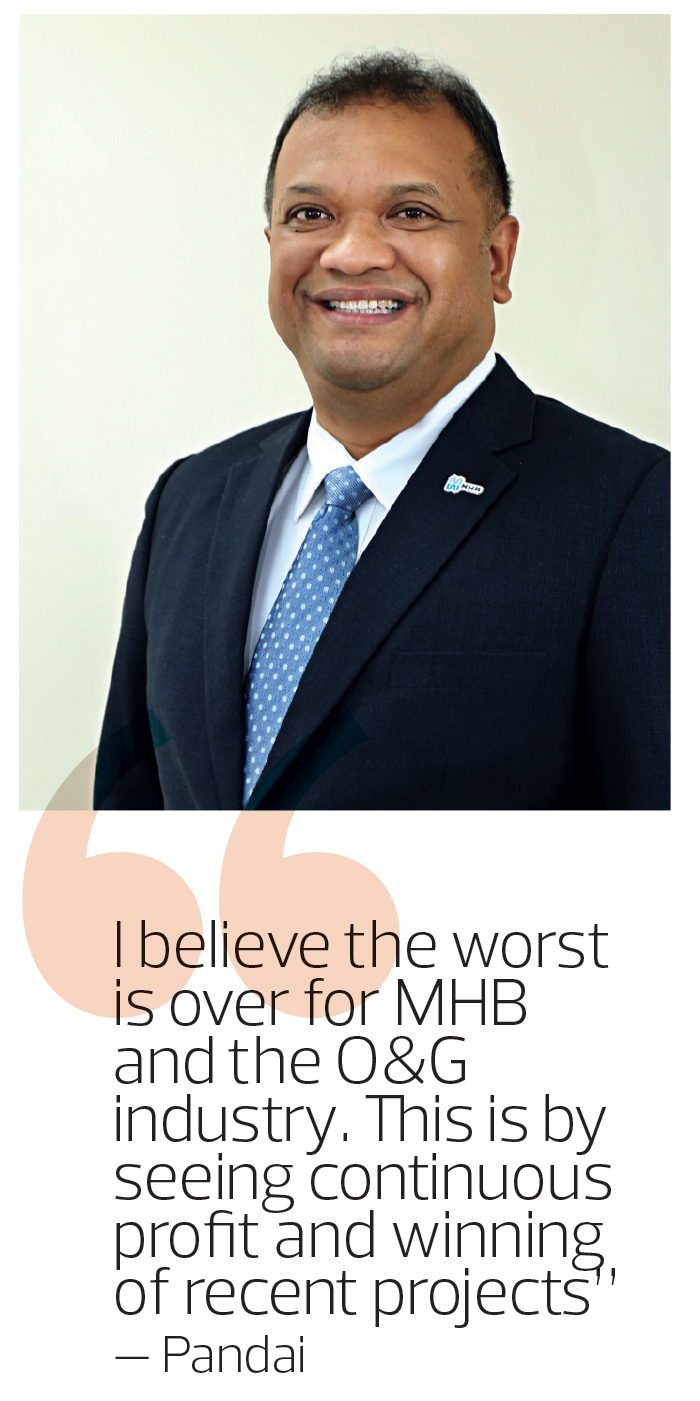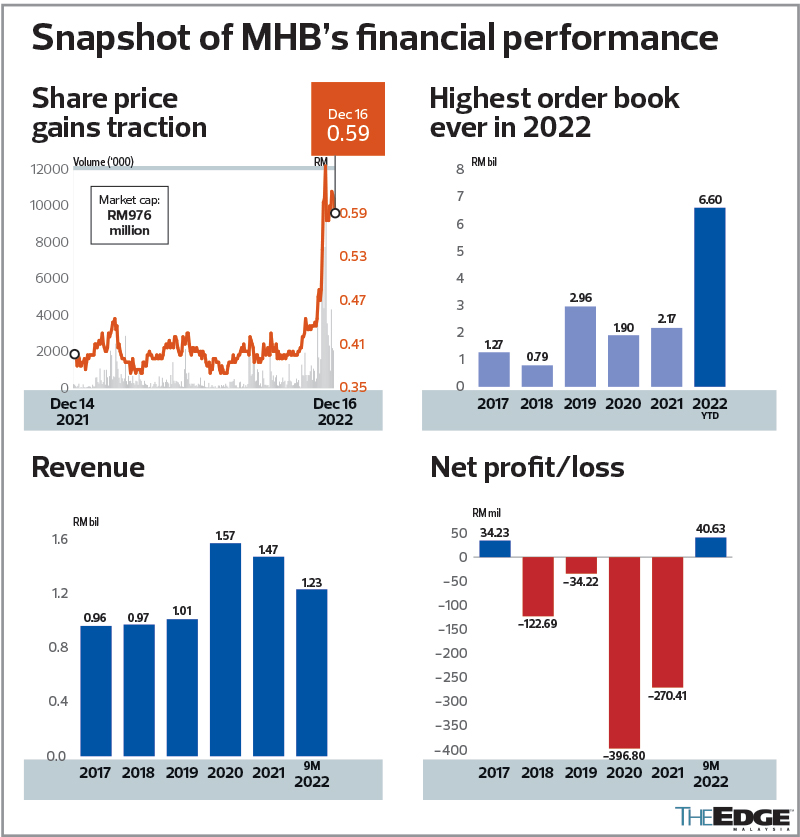
This article first appeared in The Edge Malaysia Weekly on December 19, 2022 - December 25, 2022
AFTER four years of losses, things are looking up for Malaysia Marine and Heavy Engineering Holdings Bhd (MHB). It now has a strong balance sheet, which puts it on a good footing to bid for jobs that are starting to flow again as global crude oil prices remain elevated for more than a year.
MHB, a 66.5%-owned subsidiary of MISC Bhd, which in turn is controlled by Petroliam Nasional Bhd (Petronas), had RM862.43 million in cash as at end-September while its borrowings totalled RM343.44 million, leading to a net cash position of RM518.99 million.
It is worth noting that MHB, which offers engineering, procurement, construction, installation, hook-up and commissioning of oil and gas (O&G) offshore structures and modules, runs the largest O&G fabrication yard in Southeast Asia. The 495.58-acre yard in Pasir Gudang, Johor, has a capacity of 130,000 tonnes.
Another thing going for MHB is that its current order book stands at RM6.6 billion — the highest in the history of the group — thanks to the RM4.5 billion project that it won from Petronas last month to build the country’s first carbon capture and storage (CCS) unit, which will keep the group busy until 2026.
Already, investors are bullish on the group’s recent replenishment of its order book, as evidenced by the recent spike in its share price. The stock rose 45% from end-October to 59 sen last Friday, translating into a market capitalisation of RM944 million. The counter is up 51% over the past year.
In a recent interview with The Edge, MHB managing director and CEO Pandai Othman says the group is confident of building up its order book in the coming years in view of the robust capital expenditure (capex) by oil majors. So much so he believes that O&G activities will return to pre-pandemic levels.
“I believe the worst is over for MHB and the O&G industry, looking at the continuous profit and winning of recent projects. The industry is coming back to pre-pandemic times. As we are nearing the end of the year, we are optimistic that MHB will turn around this year [barring any unforeseen circumstances],” says the 52-year-old, who took over the helm from Wan Mashitah Wan Abdullah Sani in October 2020.
Going into 2023, Pandai reckons that it will be a good year for the group to ride the upward momentum in the O&G industry’s recovery.
“We strongly believe that with such a high order book in hand, MHB is in a solid position to record a favourable financial performance. We also believe that with recent awards of major projects and a few more in the bidding phase, the O&G industry has recovered from the downturn in 2014 and has rebounded from the impact of the Covid-19 pandemic,” he says.
MHB had fallen into a loss-making position since FY2018, mainly due to less work amid a slowdown in offshore O&G activities. But the trend seems to have reversed, having delivered three straight quarters of net profit this year. For the first nine months of the year ended Sept 30 (9MFY2022), the group posted a net profit of RM40.63 million, compared with a net loss of RM162.61 million a year earlier, on the back of higher revenue of RM1.22 billion, up 19% from RM1.03 billion previously.
The bulk, or about 80%, of MHB’s revenue came from its fabrication business unit, which is mainly involved in the construction of offshore production platforms, while the remaining 20% was derived from its marine business, which undertakes ship repairs and conversions.
As a fabricator, MHB relies heavily on the capex of oil majors. But having experienced the volatility of the O&G sector, the group is pivoting some of its businesses to renewable energy projects.
While Pandai is tight-lipped on the kind of projects the group is bidding for at the moment, he does reveal that it is eyeing projects overseas, including in the region and the Middle East. The group is also bidding for wind farm projects in partnership with Belgium-based company Smulders to target the European and Taiwanese markets.
MHB’s tender book currently stands at about RM10 billion to RM11 billion, of which 70% are overseas jobs and 30% domestic. About RM2 billion to RM3 billion of its tender book comprises offshore wind farm projects.
“There are a lot of opportunities overseas, especially in the Middle East,” says Pandai, adding that diversifying abroad is part of the group’s long-term plan.
Ambitious carbon capture and storage mega project
Last month, MHB pulled off a coup by securing a massive RM4.5 billion contract from Petronas Carigali Sdn Bhd to undertake engineering, procurement, construction, installation and commissioning (EPCIC) services for the Kasawari CCS project, located off Sarawak. It is the first CCS project in Malaysia and touted to be the world’s largest offshore CCS project.
It was reported in Upstream magazine that MHB was vying for the project against UAE-based contractor National Petroleum Construction Co (NPCC). MHB had teamed up with Ranhill Worley for its successful bid, while NPCC chose Technip Energies as its engineering partner.
The CCS project is part of Petronas’ larger net zero carbon emissions target. The national oil company had stated earlier its plan to allocate 10% of its RM60 billion annual capex to non-traditional segments such as speciality chemicals, emission reduction efforts and renewable energy, to achieve its net zero carbon emissions target by 2050. The CCS project is estimated to take three years to complete, while operations are slated to start as early as end-2025.
Pandai says MHB started the engineering work for the CCS project last month, and targets to have its first steel cut — the start of the construction process — by the middle of next year.
He reckons that there is huge potential in the decarbonisation space as it will be part of the oil majors’ plans. “The opportunity to fabricate injection platforms may arise at several potential storage locations off Malaysia.”
Things are picking up
The contract awarded to MHB could be a sign of better things to come for the upstream segment of the O&G industry.
Apart from the mega CCS project, in October, MHB won an engineering, procurement and construction contract worth about RM500 million from Sarawak Shell Bhd to build a solar-powered offshore platform that is expected to be completed in 2025.
While things are looking rosy for MHB, the company is known for its lumpy earnings as it needs to continuously win projects to sustain its revenue. Analysts have highlighted the importance of improving the company’s operational efficiency to maintain its profitability, as it faced several hiccups in the past when undertaking large-scale projects.
Pandai concedes that the group faced delivery issues in those projects and took the necessary action to resolve them. He adds that in the past, the group would aggressively bid for jobs as oil majors were cutting their capex.
“First, we have an internal target of zero schedule overrun, which is something I have been working very hard on for the last two years. Second, when we take on projects, we need to make sure that we go in at the right price level. In the past, we may have gone a bit too low,” says Pandai.
“Third, we are building internal capabilities through hiring and training to help with project delivery.”
Over the last seven years, MHB has seen four changes at the helm. In October 2020, Pandai replaced Wan Mashitah, who had served as MD and CEO since January 2017 and retired in September 2020. The low-profile Pandai has almost 30 years of experience in project management with Petronas, from which he was seconded to MHB.
“We are working to make sure we space out our projects moving forward to ensure that our earnings are consistent,” he says, adding that MHB is also making sure that its yard is always ready to take on new jobs.
The group has been persistent in bidding for offshore windfarm jobs but has yet to win any.
When asked how the company was able to sail through the Covid-19 pandemic, Pandai says its plant turnaround and marine businesses have been able to absorb the shock, in addition to managing its cash flow.
It is worth noting that MHB had its fair share of challenges when the pandemic hit in 2020. In June that year, the group made a massive impairment of RM300 million following the collapse in demand for oil, resulting from the pandemic-induced border closures and lockdowns that saw economic activity come to a halt.
Despite sitting on a massive order book and having bid for contracts worth billions of ringgit, MHB has no plans to make any cash calls for now, says Pandai.
Bullish outlook
The invasion of Ukraine in February caused O&G prices to skyrocket. Russia is one of the world’s major oil exporters and Western nations have pledged to cut their dependence on the country for their energy.
Oil prices were already rising before the Ukraine war as economies started to recover from the pandemic.
Brent crude was trading at US$145 a barrel in mid-July 2008, but it tumbled to US$26 in February 2016. After several short-lived rallies, it plunged more than 65% to US$20 a barrel in April 2020 — its lowest since early 2002.
Brent crude has been trading higher this year and is now about US$81 a barrel, having fallen below the US$100 mark in late August. The commodity has averaged about US$90.14 a barrel over the past 12 months.
Pandai expects oil prices to remain strong on the back of robust demand, which will support the capex of oil majors. “As for the demand for O&G, market insight projects oil demand to peak around the year 2027, while long-term demand for gas will continue to grow at a steady rate, which supports the positive compound annual growth rate of capital spending in O&G EPCC globally for the next five years.”
Save by subscribing to us for your print and/or digital copy.
P/S: The Edge is also available on Apple's App Store and Android's Google Play.


